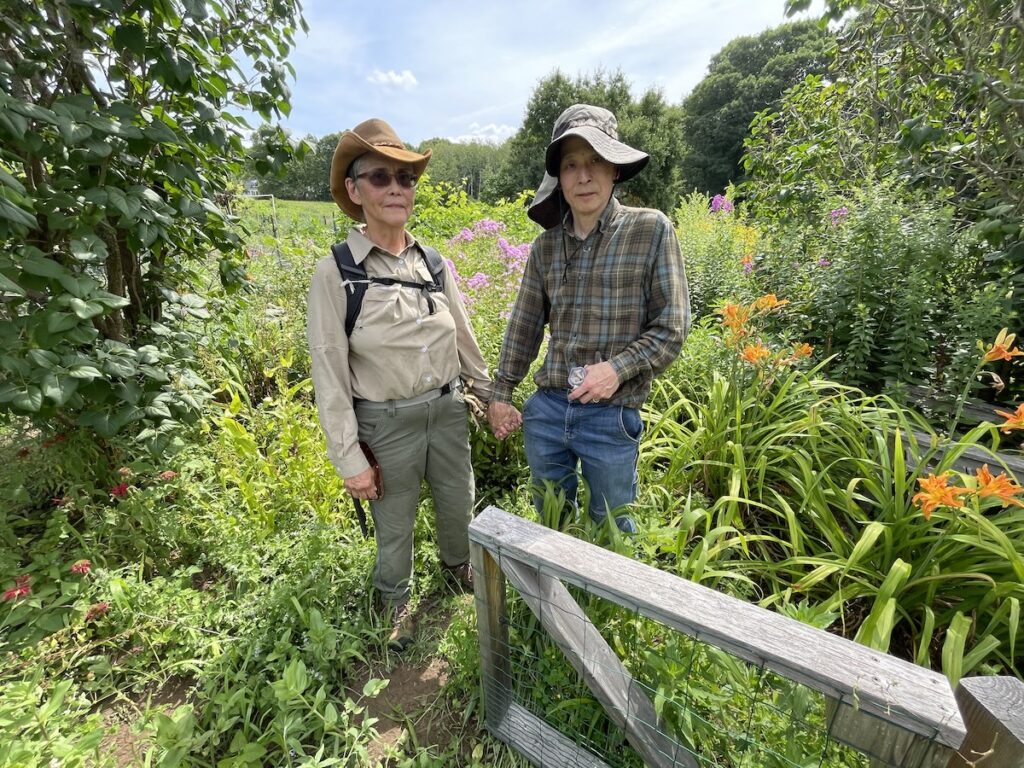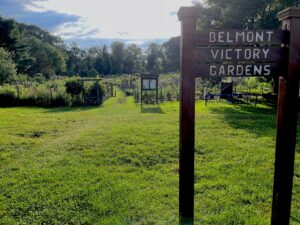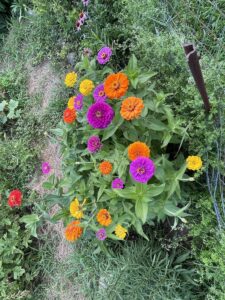
By Jeffrey North
Victory gardening in Belmont has never been more popular (local food production activity during World War II notwithstanding). One of the largest and oldest continuously active community gardens in the Boston area, Belmont’s Rock Meadow Victory Gardens consists of 132 garden plots of varying sizes, typically ranging from 12 by 12 feet to 50 by 50 feet. The gardens cover about three acres of land at the Rock Meadow Conservation Area along Mill Street, between Trapelo Road on the south and Winter Street on the north.
After glaciers retreated 10,000 years ago, Native Americans burned the land at what is now the Rock Meadow Conservation Area to keep the meadow open for hunting game and gathering food. Subsequently, the area has supported farming and grazing since the earliest colonial period, along with wool, lumber, and grain mills on Beaver Brook along the west edge of the meadow.
The Rock Meadow land was farmed by McLean Hospital from about 1895 until World War II to provide food for its live-in patients and staff. Ironically, the farm’s operations ceased due to a labor shortage, as many of the men who had worked the farm left to join the armed forces.
Patriotic Beginning of Victory Gardens
Victory gardens were part of a nationwide effort promoted by the federal government—and supported by local governments—to ease food shortages and boost national morale. At their peak, they produced up to 40% of the fruits and vegetables consumed in the United States during the war. Belmont’s victory gardens were originally located near the town center on Concord Avenue at the site of the current high school campus. In 1969, the site was earmarked for athletic fields, and the gardens were moved to the town’s new conservation land at Rock Meadow.
The term “victory garden” comes from World War II (replacing the term “war garden” used in World War I). People were encouraged to grow food to support the war effort. In Belmont, hundreds of garden plots were cultivated all over town.
Hundreds of school children and high school students were recruited and organized to work the mini-farms in their backyards or at many locations around town. Schools gave classes in gardening instruction. “It is hoped,” wrote the Belmont Citizen newspaper in April 1943, “that many youngsters who formerly went away for the summer will feel the patriotic urge to cooperate this summer and help do the work that their older brothers used to do, and thus help solve a serious national problem.”
The Victory Garden Committee, chaired by Margaret Barnes of Fletcher Road, organized the allocation of land and labor, procurement of seeds, distribution of supplies, and instruction to tenderfoot citizen farmers. The gardens were a model of efficiency and public commitment. In October 1946, at a luncheon ceremony at the Copley Plaza Hotel, Barnes received a special award from the Federation of Garden Clubs of Massachusetts for her Victory Garden project efforts. Her project plan was adopted by many towns throughout the Commonwealth between 1943 and 1945.
The town engaged in friendly but serious competition with neighboring towns to see which communities could produce the greatest amount of farmed food. Belmont produced surpluses of its produce and shipped impressive quantities of preserved fruits and vegetables to help feed America’s armed forces. Citizens proudly presented their crops at the Harvest Show of WWII, where 300 exhibits showed the produce from town gardeners’ labor in September 1943.
During the 1970s, a time of “back to the land” and “grow your own,” community gardening underwent a nationwide renaissance. Community gardens sprang up or were revitalized everywhere, in vacant inner city lots and suburbs like Belmont. By the 1980s, though, interest in community gardens waned.
By the end of the 1990s, many community gardens across the country had been bulldozed for other uses. The victory gardens at Rock Meadow were protected from that fate, although more and more plots became abandoned. Bruce Westgate, a Belmont architect, took over the management of the gardens for the next few decades. His guidance and encouragement kept the gardens active despite decreasing interest in community gardening. Gino Volpe, another long-time gardener, managed the water system for the gardens during this period. The system was an act of love to the garden community; it was highly functional and entirely managed by volunteer “engineers.” While operating at less than full capacity, approximately 60 gardens remained tended throughout the next few decades.

Volunteers Aleida Leza and Darin Takemoto remove invasive plants from one of the pollinator plots held in the commons, which benefits the gardens (and the pollinators). Photo: Jeffrey North
Circa 2003, things began to change, first for Rock Meadow and then for the Victory Gardens. Deborah Hartman, resident of the Kendall Gardens neighborhood adjoining Rock Meadow, brought together some of her neighbors and other citizens in Belmont to share their concerns about the gradual loss of the meadow to reforestation. They formed a citizens group, the Friends of Rock Meadow, and for two years raised money to help pay for mowing. Then, in 2005, they partnered with the Belmont Conservation Commission and raised over $75,000 in matching grants to create a long-term management plan. As trees were removed, the community gardens became visible along the Meadow and Mill Street, spurring renewed interest in the gardens.
Improved visibility and reduced shade in the victory gardens created renewed community interest. In spring 2007, there was a threefold increase in applications for garden plots over the previous year; all vacant plots were assigned, and a waiting list was started. Plots were divided, or reestablished, in the spring of 2008 to accommodate the demand, and again in 2010, with 16 more plots added. Large plots that had earlier been conjoined were divided, and 12 abandoned plots were reclaimed. Currently, there is a waiting list of almost 250 wannabe gardeners.
Restoring the vista from Mill Street and Concord Avenue also prompted criticism of the aesthetics of the garden plots. A common complaint of residents concerned the appearance of the plots, which were often defined by a wide variety of products. The term “shanty town” was employed more than once. At the time, fencing at the perimeter of each plot was unique. Fences were constructed from building debris, aluminum or vinyl siding strips, pieces of baby cribs, old window screens, lawn furniture, and the like. In response to neighbors’ concerns, gardeners took it upon themselves to remove much of the debris, and garden fees were used to purchase uniform wire fencing. Work days were devoted to cleaning up trash and accumulated debris, and soon, the comments from visitors were far more positive. Portions of the garden were landscaped by the community and included planting of a perennial flower bed at the entrance to the gardens.
Since the Rock Meadow property was purchased by a combination of federal and local monies, creating a regional recreational facility, plot assignments are no longer limited to Belmont residents. Current gardeners hail from all of the towns surrounding Belmont, with about a quarter of the garden community from outside of Belmont.
There is a striking diversity in the gardener community, with up to a dozen languages spoken in the plots. This diversity has extended to the agricultural techniques and in the variety of produce garnered from the plots. Currently, there are community plots held by a sheltered workshop from McLean Hospital; the Belmont Food Pantry; family groups; and other local teams. Management of the garden also shifted from a single manager, to a team of committed gardeners. This has shifted much of the garden-related decision-making to the community and a seven-member board rather than a single person.
In recent years, Rock Meadow has added beekeepers and bee hives to the agricultural uses on the property. Currently, approximately eight teams of beekeepers manage between 12 and 24 hives throughout the growing season. Adding pollinators to the meadow has assisted gardeners with pollination, and produced gallons of local honey.
Today, Belmont Victory Gardens’ mission is to provide accessible space for gardeners in an active, supportive gardening community. Gardeners contribute to Rock Meadow conservation and are committed to educating gardeners on sustainable organic methods.
How to Apply for a Victory Garden Plot
Registration for garden plots begins in late February. Returning gardeners may complete a 2025 registration form and mail or hand deliver it with your check payment to the Town of Belmont, Attn: Mary Trudeau, Belmont Conservation Agent, 19 Moore Street, Homer Building, Belmont, MA 02478. To get on the waitlist for a garden plot, contact Mary Trudeau at mtrudeau@belmont-ma.gov or 617-993-2667.
Garden fees are decided each spring but have remained at $75 for a number of years. Fees include water use, and often include group deliveries of compost or wood chips. Water taps are spaced throughout the gardens where hoses can be attached. Water is turned on in early May and turned off in mid October. Maintenance of the water system is generally done by volunteer gardeners, assisted by the Belmont Department of Public Works.
Garden Rules and Information
Rules and etiquette enable community gardens like ours to function and thrive. For more information on the Belmont Victory Garden, please read the 2023 Garden Handbook.
Community Gardens at Habitat
Communal gardening opportunities also can be found at the Community Garden plots at Mass Audubon’s Habitat property. Habitat has 10 plots for seasonal rent of $75 to members of Mass Audubon (Living in Belmont is not a requirement). The area also has several communal garden plots, raised beds for propagating plants for replanting around Habitat, the Sun & Moon Herb Garden, and a children’s garden. Audubon staff reminds gardeners that they are in a wildlife sanctuary, so they must be prepared to share their bounty with deer, groundhogs, rabbits, and other such wild creatures that browse fruit, flowers, and veg. Any members of Mass Audubon interested in renting a garden plot may send an inquiry to Habitat@massaudubon.org.
Thank you to Stephen Pinkerton, Mary Trudeau, Victoria Thatcher, Curtis Adams, Richard Betts, Terry Bragg, Deborah Hartman, Margaret Velie, the Belmont Conservation Commission, and the digital archives of the Belmont Public Library for Belmont Citizen newspaper articles from the 1940s.
Jeffrey North is the managing editor of the Belmont Citizens Forum Newsletter.




Sorry, the comment form is closed at this time.